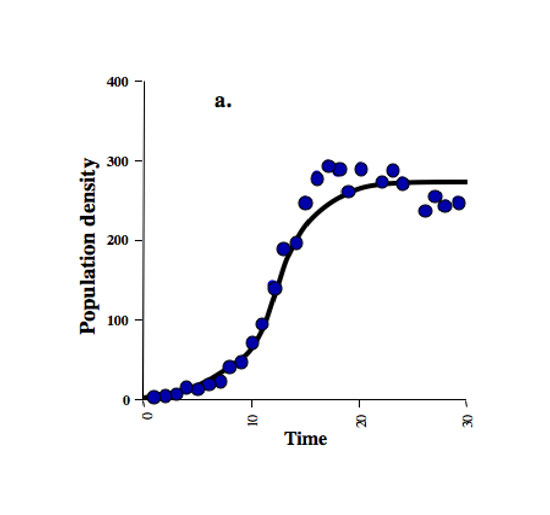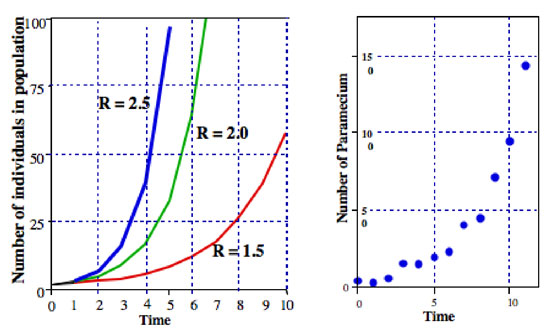Let's start with the basics: Exponential Growth
Exponential growth is a type of population growth in which the rate of increase in the number of members is proportional to the number present.
To model exp. growth we use the below formula:
To model exp. growth we use the below formula:
N(t)= N(0)*(e^(R*t))
Where (N(0)): initial population size; (N(t)): the projected population size; R: intrinsic growth rate; and t: an arbitrary time.
Where (N(0)): initial population size; (N(t)): the projected population size; R: intrinsic growth rate; and t: an arbitrary time.
The figure (right) depicts the extent to which rate (R) affects population size over time (t), given we know the population size at t initial. Note the "J-shaped" growth curve. (I have not figured out how to use super-/sub-scripts in blogger, sorry!)
Geometric Growth Model
Geometric growth model (equation below) expands upon the exponential growth model by Including discrete time steps as a variable, which is important for species that have defined growth periods (e.g., breeding season).
N(t)= N(0)*(R^(t))
When R>1 the population is increasing; R<1 pop. decreasing; R=1 no change in pop. size.
 |
| (Knowledge Library, Nature.com) |
Density Dependence
Density dependent factors affecting population size, such as competition or predation are often biotic, whereas density independent limitations are often abiotic, such as environmental stress.
Logistic Population Growth
This equation is density dependent, that is, as the population increases, intraspecific competition increases. The logistic growth model is a common sigmoid curve or "S-shaped" curve, as seen in the carrying capacity graph above.
To find the change in population size over time (dN/dt) while accounting for carrying capacity (K) we use the following equation ("Equation 8"). Where N = population size and r = rate of population change.
| (Knowledge Library, Nature.com) |
The Allee Effect, or Inverse Density Dependence at Low Density
 |
| (Ann. Rev. in Ento., 2008) |
The many factors that may lead to the Allee Effect have been loosely categorized as follows:
1) Genetic Inbreeding - leading to decreased fitness
2) Demographic Stochasticity (e.g., sex-ratio fluctuations, or low fecundity)
3) Reduced intraspecific cooperation when densities are low
In practice, the Allee effect is of concern to conservation biologist. Instances such as managing rare species, monitoring species re-introductions, or preventing the establishment of non-native invasive species all involve small population sizes.
Lotka-Volterra competition model
Note: The L-V model is Community Ecology, but is included here because it builds on the population ecology models we have learned about.
This model builds on the logistic growth model, by adding a competition coefficient, accounting for a species' ability to inhibit the growth of another (interspecific competition). The equations below are the logistic growth model as discussed above for individual species (species 1, species 2), but a competition coefficient has been added.
Competition coefficients may be denoted as alpha or beta, or as in this example, subscripts on the alpha are different. This coefficient represents the degree to which their competitor may inhibit their growth (alpha) and the size of the competitor's population (N).
| (Townsend et al. 2008. Ecology) |


No comments:
Post a Comment
Please contact me at Shappell.Ecology -at- gmail.com if you have any questions, comments, or concerns regarding the content of this blog.